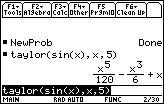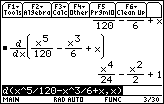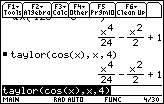In Lesson 22.2 you found Maclaurin series that approximate functions near x = 0. This lesson investigates how to find a series that approximates a function near x = a, where a is any real number.
Defining a Taylor Series
Given a function f that has all its higher order derivatives, the series
![]()
where
![]()
is called the Taylor series for f centered at a. The Taylor series is a power series that approximates the function f near x = a.
The partial sum
![]()
is called the nth-order Taylor polynomial for f centered at a.
Every Maclaurin series, including those studied in Lesson 22.2, is a Taylor series centered at zero.
Finding Taylor Polynomials
The TI-89 taylor( command can be used to find partial sums of Taylor series.
|
|||
|
|
|||
Find the second-order Taylor polynomial centered at 1 for the function f(x) = ex.
- Enter taylor(e^x, x, 2, 1)

Near
![]()
The series above is similar to the Maclaurin series for y = ex found in Lesson 22.2. However, the terms in this series have powers of (x - 1) rather than powers of x and the coefficients contain the values of the derivatives evaluated at x = 1. The coefficient of the term (x - 1)k is
![]()
More Taylor Polynomials
The polynomial you found in Lesson 22.2,
![]() , was tangent to y = ex at x = 0 and has the same concavity as y = ex at that point. The polynomial
, was tangent to y = ex at x = 0 and has the same concavity as y = ex at that point. The polynomial
![]() , which is centered at
, which is centered at
x = 1, is tangent to y = ex at x = 1 and has the same concavity as y = ex at that point.
22.3.1 Find the fifth-degree Taylor polynomial centered at 1 for y = ln x and interpret the result. Click here for the answer.
22.3.2 Find the fourth-degree Taylor polynomial centered at 1 for
![]() . Click here for the answer.
. Click here for the answer.
22.3.3 Describe the relationship between the two polynomials found in 22.3.1 and 22.3.2. Click here for the answer.
22.3.4 Predict the relationship between the fifth-degree Maclaurin polynomial for y = sin x and the fourth-degree Maclaurin polynomial for y = cos x. Click here for the answer.
Verify your prediction of the relationship between the Maclaurin polynomials for
y = sin x and for y = cos x with the commands show below.
- Execute taylor(sin(x), x, 5)

- Enter the derivative command d( on the Edit Line
- Paste the last result from the History Area to the Edit Line
- Execute d(x^5/120 – x^3/6 + x, x)

Find the fourth-degree Maclaurin polynomial for y = cos x.
- Execute taylor(cos(x), x, 4)

The results are the same as predicted.